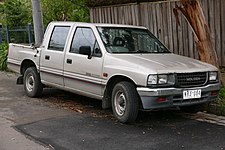Holden Rodeo
| Holden Rodeo | |
|---|---|
 | |
| Overview | |
| Manufacturer | General Motors |
| Production | 1980-2008 |
| Body and chassis | |
| Class | Compact pickup truck |
| Body style | 2-door regular cab 2-door regular cab SWB 2-door extended cab 4-door crew cab |
| Layout | Front-engine, rear-wheel drive/four-wheel drive |
| Chronology | |
| Successor | Holden Colorado |
The Holden Rodeo is a utility vehicle (pickup truck) that was sold in Australasia (Australia and New Zealand) by Holden. Introduced in 1980, the Rodeo was built by Isuzu over three generations. In 2008 Isuzu and Holden went their separate ways. Holden went with the U.S Chevrolet Colorado and rebadged it the Holden Colorado, while Isuzu went with the ute that so many Australians and New Zealanders had come to love and released the Isuzu D-Max.
Prior to the launch of the Holden Rodeo, Holden had imported the first generation Japanese market Isuzu Faster into Australasia under the names Chevrolet LUV (1972–1977) and Isuzu LUV (1977–1980).[1][2] At the Australasian release of the second generation Faster in December 1980, Holden once again introduced a new name—Holden Rodeo—assigning it the model code KB and thus becoming the first generation Holden Rodeo.[1][3]
Isuzu in Japan released the redesigned Faster in May 1988,[4] adopted and issued by Holden in August 1988 as the second generation TF series Rodeo.[5] The TF had several designations over its lifespan. The R7 was the first major facelift, introduced in 1997, featuring a completely new bonnet, front quarter panels, and grille. This was the last Rodeo to have chrome bumpers. The R9 arrived later in 1998, which replaced the chrome bumper with plastic bumpers on all models. A V6 engine became available for the first time, which proved very popular. An optional driver's airbag became available for the first time in 2000. In 2001, Rodeos received updated tail lights with clear indicators, replacing the previous orange-coloured ones. Larger composite headlights replaced the previous rectangular sealed beams. A final update in 2002 saw the circular Holden logo appear on the grille, replacing the "Holden" lettering. The 4JB1T turbo diesel engine proved popular in 4x4 models despite its rough idling characteristics. 4JB1T in the 4x4 models was fuel efficient even with 4.55:1 differential ratios giving higher engine RPM at highway speeds. By the end of its use in the R9 the 4JB1T reached Euro 2 emission standards. Later in the R9 lifespan the 4JH1 was available as an option with more power (96KW) and higher gearing before it became the only diesel available in the all new RA due to the 4J1BT's inability to meet emission standards.
Although Japanese sales of the Isuzu Faster ceased in October 1994,[4] it remained in production until general exports began in June 2003 of its Thai-produced replacement, the Isuzu D-Max which launched in its home market of Thailand in May 2002.[6] Australasian sales began in March 2003, earlier than other export markets, as the third generation RA series Holden Rodeo. At this point Holden retired the long-running TF model.[7] Holden maintained sales of the RA generation until rebranding the Rodeo as Holden Colorado in July 2008.[8] This was a result of Holden losing the rights to the Rodeo name following General Motors split with Isuzu.[9]
 First generation (KB; 1980–1988)
First generation (KB; 1980–1988) Second generation (TF; 1988–2003) R7 2wd version shown
Second generation (TF; 1988–2003) R7 2wd version shown Third generation (RA; 2003–2008)
Third generation (RA; 2003–2008)
References[]
- ^ a b Bebbington (2009), p. 279. "GM-H had been importing light and heavy Isuzu trucks from Japan since the early 1970s. First of these was the Isuzu KB utility, sold as the Chevrolet LUV (Light utility Vehicle). The reputation and recognition of this little utility grew over time until in 1977, the Chevrolet name was deleted and the Isuzu nameplate was used instead. Late in 1980, KB received a major
facelift[redesign]. With new sheetmetal, the opportunity was taken to re-badge the car – this time as Holden Rodeo." - ^ "Holden Rodeo (Isuzu Utility)". GoAuto. John Mellor. Retrieved 8 May 2011.
- ^ Bebbington (2009), p. 279. "KB Rodeo: December 1980 to August 1988".
- ^ a b いすゞの車種一覧 [List of Isuzu vehicles]. Car Sensor Lab (in Japanese). Recruit. Archived from the original on 20 April 2011.
- ^ Bebbington (2009), p. 281. "TF Rodeo introduced in August 1988, was the replacement for the successful KB series."
- ^ "Isuzu's All New Pickups Popular in Thailand and Australia". Isuzu Motors. 18 April 2003. Archived from the original on 28 September 2011.
- ^ Bebbington (2009), p. 281. "RA Rodeo: March 2003 to current"; "RA Rodeo introduced in early 2003, superseded the long-running TF series."
- ^ Sinclair, Mike (1 July 2008). "Colorado rolls over Rodeo runout". Carsales. Retrieved 8 May 2011.
- ^ Pettendy, Marton (4 March 2008). "Holden to retire Rodeo". GoAuto. John Mellor. Retrieved 19 March 2008.
Bibliography[]
| Wikimedia Commons has media related to Holden Rodeo. |
- Bebbington, Terry (2009). 60 Years of Holden. Padstow, New South Wales: Haynes Manuals. ISBN 1-876953-58-6.
- Set indices on cars
- Holden vehicles
- Cars introduced in 1980


